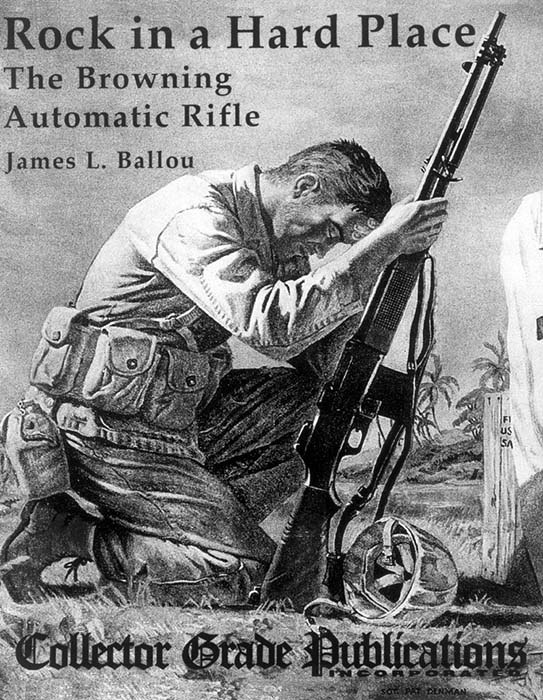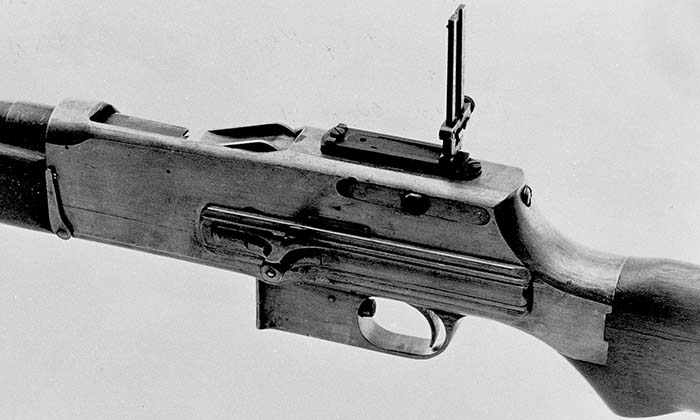Right hand view of prototype #1. Courtesy William Douglas and Browning Firearms Museum.
By James L. Ballou
My book is finished, five years and a host of friends have produced a 500-page tome that I hope will be well received by my friends and colleagues. Rock in a Hard Place, the story of the Browning Automatic Rifle can be found on the bookshelves and is available from the usual sources. There is a list of 150 people that contributed to my book, but I would like to thank all who contributed materials and support to my work.

Contrary to my opening sentence, my research is not finished, it is still a work in progress.
Many questions remained unanswered, and whole sections are missing. The sad thing is much valuable historical material has been destroyed or ignored by the companies involved. There is a dearth of material on Royal TypeWriter who produced 61,000 BAR’s during the Korean War. Why were some BAR’s marked BOSTICH? The best I could find was that BOSTICH was a division of Stanley Tool who made magazines and bolt parts. Did they recondition some BAR’s or did they subcontract receivers? I still would like to answer these questions.
So I am appealing to you RKI’s out there to fill in the blanks. I had a 20th Chapter in my manuscript called “Number Games” where I tried to establish the serial number ranges of all six major manufactures. Accounting for overlapping and large gaps from over two hundred examples, I tried to establish the ranges from extrapolation.
A couple of ground rules. Serial number one has no validity as everyone produced one. Note that Colt started at 12,701. Often there will be overlapping and a suffix will be added. Next, anything ending in 000 will probably be a special piece reserved for presentation.
I am enclosing my estimation of the serial number assignment, in the hopes that you, my friends, will clarify and solidify the list.
One personal mystery I would like answered, is why was the leather scabbard produced to accommodate the BAR without the bipod and how was it mounted in a vehicle?

It is up to you, “The precious remnants” of the “greatest generation” to answer these enigmas. My book was written not only to record the saga of the BAR, but also to pay homage to the brave men who used the BAR to make the world “safe for democracy”.

Researching the caliber’s of the BAR produced some rather interesting results. The 280/30 story of the British assault weapon cartridge is well documented in my book. Not mentioned is the startling find by Stan Andrewski of a 7.62 x 39 Belgian BAR. Also, not mentioned from Brophy’s book on Marlin Firearms is a special .22 caliber training BAR produced and state by the US Marine Corp. This was a fully automatic .22 Long Rifle in BAR configuration demonstrated in August of 1956 by Tom Robinson at Quantico, Virginia. Though not adopted, it was a great idea.
Finally, Professor Ed Libby, who offers a unique insight into this controversy, mentions the Japanese BAR in 6.5mm or 7.mm.
The truth often comes out of controversy. I eagerly seek comments, objections and additions.
James L. Ballou
90 Lafayette Rd.
Salisbury, MA 01952
978-465-5561
jimballou@hotmail.com
THE SECRET OF THE ROCK
I first wrote about the BAR for the old Machine Gun News in 1996, “The B.A.R.: USA’s First S.A.W.” I stated, “In its initial conception, the BAR fired from the closed bolt, and ejected from the top.” Though I was skeptical, I dutifully reported this fact. Many questions troubled my mind; I could not see how the firing pin could be struck after the bolt was closed. Many years went by as I researched the book, Rock in a Hard Place. I consulted all of the greatest minds in the business to no avail. Then, I presented the problem to Bill Vallerand whom I describe as “our national treasure.” Bill has forgotten more about BAR’s than I will ever know when I “wrote the book on them.” He was as baffled as I was.
So, like any good reporter we must go to the source. I spoke to the one man who had access to the primary source, the prototype, Mr. Byron L. Lewis of the Union Station Depot, Browning Museum in Ogden, Utah. This was the “Mother Lode.” He was able to remove the Number 1 gun from its display case and lay hands on the “Holy Grail.” His superiors would not let him detail strip the gun, more the pity. In an historic phone call, I spoke to Byron as he handled the very rifle. Three times he pulled the operating handle back and the bolt would not stay back. Then I asked him to pull the trigger. A loud “click” ensued. The hammer now hit the firing pin! The number one prototype fired from the closed bolt.
The mystery and secret still remained hidden; how did John Browning get the mechanical delay necessary to strike the firing pin?
The book was published and I eagerly awaited Bill Vallerand’s call to hear his reaction. “Gooood!” was his reply and we went over it page by page looking for mistakes.
I then directed him to page 135, figure 149. It then struck me like a lightening bolt! The operating slide is in two parts and the hammer has a slot and not a hole. There are two distinct movements of the parts of the operating slide. This is the secret of the ROCK.
This Aberdeen Proving Ground photo supplied by Robert W. Faris dated August 23, 1938 must be an experimental closed bolt-firing B.A.R. based upon John Browning’s original prototype.
| This article first appeared in Small Arms Review V4N8 (May 2001) |











